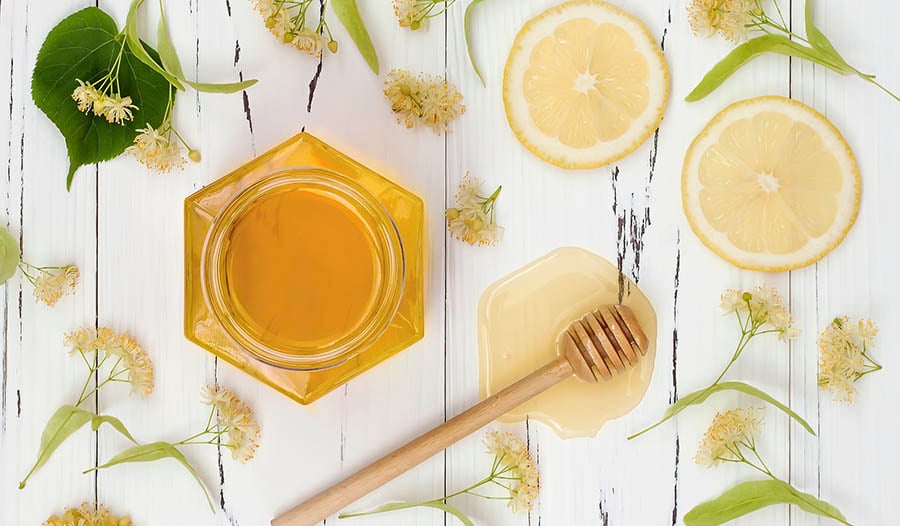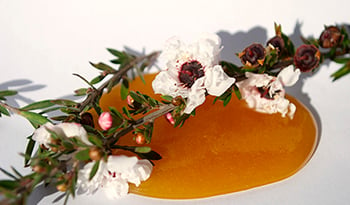5 Manuka Honey Benefits: Digestion, Skin Health, Sore Throats, and More
DISCLAIMER:This blog does not intend to provide diagnosis...
- In this article:
- What Is Manuka Honey?
- 1. Manuka Honey's Digestive Health Benefits
- 2. Manuka Honey's Wound Repair Benefits
- 3. Manuka Honey's Skin Health Benefits
- Manuka Honey Facemask Recipe
- 4. Manuka Honey's Sore Throat and Cough Benefits
- Homemade Manuka Honey Cough Syrup Recipe
- 5. Nasal and Sinus Irrigation Benefits
- How to Make a Neti Pot With Manuka honey

Originally posted June 2018 / Updated January 2023
Since ancient times honey has been beloved for its tasty sweetness and health benefits. Revered by global cultures, in Roman times, honey was so valuable it could be used to pay taxes. Nowadays, honey is produced in mass quantities and used primarily as a natural sweetener. Manuka honey has gained a tremendous reputation above all others regarding health benefits.
What Is Manuka Honey?
As the name manuka implies, Manuka honey is produced from the flowers of the manuka tree. This tree grows in Australia and New Zealand and is also known as tea tree along with Melaleuca alternifolia. The two trees are different species from the Myrtle tree family and share some common characteristics, including being rich in aromatic essential oils. Both tea trees were used as a source of essential oils to produce topical preparations for skin and wound care. And flowers from both trees produce nectar and pollen collected by honeybees. To officially count as Manuka honey, at least 70 percent of the pollen in the honey must come from manuka flowers.
Manuka honey was highly regarded in New Zealand in early Māori traditions and considered a taonga or “treasure” due to its wide variety of uses. It is now a significant source of income to the New Zealand economy, with annual exports likely over $500 million (USD). It seems that Manuka honey is becoming a treasure around the world.
Manuka honey is often easy to distinguish from other types of honey, experts mainly focus on its thickness, color, and taste. True Manuka honey is very thick and viscous. Some Manuka honey may be so thick that it has a texture more like jam than syrup. The honey produced from Manuka flowers also has a dark brown color. This distinctive color is often used as a quick and easy way to identify Manuka honey.
While Manuka honey can be used as a natural sweetener, much more economical options are available for this application. Instead, Manuka honey is used for its many health benefits. Its sweet taste makes it easy for individuals to enjoy the healing properties of Manuka honey.
Manuka honey is special because it contains some unique compounds not found in other types of honey. An example is methylglyoxal or MGO. This compound is produced at unusually high levels from the dihydroxyacetone found in manuka flowers. Manuka honey also contains many flavorful compounds from manuka flowers, so it has an earthy, herbaceous taste and scent. Manuka honey also has special proteins and colloids that give it its distinctive texture.1
Most of the research trying to unlock the secrets of Manuka honey has focused on MGO content. For example, MGO is regarded as the vital compound attributed to the effectiveness of topical Manuka honey for healing wounds, burns, and cuts. Research has shown high MGO content Manuka honey to exert effects against some types of particularly harmful and antibiotic-resistant bacteria.1-5 Manuka honey also contains naturally occurring amounts of hydrogen peroxide, a well-known topical disinfectant frequently used to aid wound healing, and several other unique compounds.
Earning the title of Manuka honey requires adherence to rigorous production standards. Honey labeled “New Zealand Manuka Honey” has been carefully tested and regulated to ensure that it is made from manuka flowers. Shoppers can find particularly potent and pure Manuka honey by looking at the Unique Manuka Factor (UMF) rating on the honey. This rating is a particular scale called that measures the amount of MGO and other beneficial compounds in the honey, such as leptosperin and dihydroxyacetone (DHA), to assign a value to the quality and purity of honey. If you are looking for the health benefits from Manuka honey, the UMF rating must be at least 10.6
There are many different uses for Manuka honey since it exerts so many healing effects. This article provides a few of the most popular uses.
1. Manuka Honey's Digestive Health Benefits
Perhaps the most extensive use of Manuka honey is as a general aid to well-being. The second is to support the health of the gastrointestinal tract. Preliminary studies support this use. Foremost, Manuka honey helps to promote the health of the gastrointestinal lining from the mouth to the colon.8-12 In particular, clinical studies show Manuka honey can reduce the suffering in the inflammation of the mouth caused by chemotherapy or radiation therapy for cancers of the head or neck.11,12 One tablespoon of Manuka honey held in the mouth for at least one minute twice daily can work wonders.
In addition to soothing inflammation and supporting the lining of the mouth, throat, and intestine, the antimicrobial effects of Manuka honey appear to be excellent for keeping the digestive system healthy. Manuka honey inhibits the growth of harmful bacteria while providing natural prebiotics to boost the production of beneficial bacteria. As a prebiotic, Manuka honey contains a high level of oligosaccharides (5-10%) compared with other types of honey.1 These non-digestible carbohydrates encourage the growth of beneficial gut bacteria necessary for a healthy digestive function. This can help to ease common minor digestive issues such as gas, bloating, indigestion, and irregular bowel movements. Generally, one or two tablespoons of Manuka honey per day are taken for these purposes.
2. Manuka Honey's Wound Repair Benefits
Another key use of Manuka honey is promoting skin health and healing wounds. It helps fight off bacteria that would otherwise lengthen healing times and provides beneficial proteins and other compounds that promote tissue repair. Manuka honey can be spread over a mild burn or more minor abrasions, but it must never be applied to a deep wound. It should be applied to minor wounds to prevent scarring and continue even after a new scar has formed until there is complete healing. Its healing properties and moisturizing benefits can help speed healing, prevent scar formation, and keep skin flexible.
3. Manuka Honey's Skin Health Benefits
The properties that make Manuka honey helpful in healing minor wounds and abrasions are also great for keeping skin healthy. For example, Manuka honey can fight inflammation and bacteria that cause acne when applied to the face. It also provides plenty of moisture to keep skin looking firm and youthful. Another great benefit of Manuka honey for the skin is that it brings the skin's pH to optimal levels, which prevents dryness, redness, and acne. The low levels of hydrogen peroxide and antioxidants in Manuka honey can even help to fade dark scars left behind from past acne. The simple homemade face mask below will help to even skin tone and prevent acne when applied a couple of times each week.
Manuka Honey Facemask Recipe
Ingredients:
- 1 tsp. Manuka honey
- 1/2 tsp. cinnamon
- 1/2 tsp. rose water
Instructions:
- Mix all three ingredients in a small bowl or jar.
- Use clean hands or a cotton pad to smoothly spread the mixture over the skin.
- Leave the face mask on for at least 20 minutes. The active ingredients will continue to provide benefits for up to an hour.
- Rinse the mask off with warm water and dry the skin gently.
4. Manuka Honey's Sore Throat and Cough Benefits
The healing properties of Manuka honey are commonly used as a home remedy to relieve coughs and sore throats. There is clinical evidence to support the use of honey for these purposes. For example, in a clinical trial involving 300 children between the ages of 1 and 5, treatment with honey reduced the frequency and severity of night-time cough and improved sleep for both the child and parents.13 The benefits of honey are so well recognized many medical organizations recommend honey for soothing a sore throat or cough in adults and children (> 1 year old). Examples are the Center for Disease Control and Prevention (CDC) in the United States and the National Institute for Clinical Excellence (NICE) in the United Kingdom.
Homemade Manuka Honey Cough Syrup Recipe
Ingredients:
- 2 cups water
- 8 Tbs. chopped, fresh thyme
- 1 cup Manuka honey
Instructions:
- Put the water in a small saucepan over medium-high heat and let it come to a boil.
- Remove boiling water from heat, add thyme, and let the concoction steep for at least 10 minutes.
- Pour in the Manuka honey and stir until thoroughly dissolved.
- Pour mixture into an airtight, glass jar, straining if desired.
This cough syrup will be good for at least three weeks if refrigerated, and a spoonful each time the throat feels rough can be very helpful.
5. Nasal and Sinus Irrigation Benefits
Manuka honey can also be added to solutions to rinse the nasal and sinus lining. Clinical studies demonstrated promising results in people with chronic congestion and those with cystic fibrosis.14,15 In the later condition, there is decreased function of the hair, like cilia that move mucus up and out of the airways.
The most practical way to create a nasal and sinus rinse with Manuka honey is to use a neti pot, a small container designed to clear debris or mucus from your nasal cavity. Neti pots have become a popular self-care treatment for nasal congestion. Generally, once a day is sufficient, but twice per day is recommended for no more than 7-10 days in active congestion.
How to Make a Neti Pot With Manuka honey
- Add 1 teaspoon of salt with 1/4 teaspoon of baking soda to 8 ounces of distilled, sterile, or previously boiled and cooled water. Do not use tap water.
- Add 1 tablespoon of Manuka honey and stir to thoroughly dissolve in the solution.
Most neti pots come with instructions. Here are the basics:
- Tilt your head over a sink at about a 45-degree angle.
- Follow the instructions in the box when using a neti pot.
- Pour the saline solution into one nostril and out the other by placing the spout into your top nostril and slowly pouring the saline solution into that nostril. The solution will pass through the nasal cavity and out the other nostril.
- If any of the solution runs into the throat, spit it out.
- Blow your nose to get rid of any remaining solution, then refill the neti pot to repeat the process on the other side.
- Be sure to wash, rinse, and completely dry the neti pot after each use.
- If the neti pot has no metal, occasionally put it in the microwave to help ensure pathogenic organisms don’t build up.
References:
- Alvarez-Suarez J., Gasparrini M., Forbes-Hernández T., Mazzoni L., Giampieri F. The Composition and Biological Activity of Honey: A Focus on Manuka Honey. Foods. 2014;3:420–432.
- Carter DA, Blair SE, Cokcetin NN, Bouzo D, Brooks P, Schothauer R, Harry EJ. Therapeutic Manuka honey: no longer so alternative. Frontiers in microbiology. 2016 Apr 20;7:569.
- Blair SE, Cokcetin NN, Harry EJ, Carter DA. The unusual antibacterial activity of medical-grade Leptospermum honey: antibacterial spectrum, resistance and transcriptome analysis. European journal of clinical microbiology & infectious diseases. 2009 Oct 1;28(10):1199-208.
- Cooper RA, Halas E, Molan PC. The efficacy of honey in inhibiting strains of Pseudomonas aeruginosa from infected burns. The Journal of burn care & rehabilitation. 2002 Nov 1;23(6):366-70.
- Hayashi K, Fukushima A, Hayashi-Nishino M, Nishino K. Effect of methylglyoxal on multidrug-resistant Pseudomonas aeruginosa. Frontiers in microbiology. 2014 Apr 17;5:180.
- Girma A., Seo W., She R.C. Antibacterial activity of varying UMF-graded Manuka honeys. PLoS ONE. 2019;14:e0224495.
- Weston RJ, Mitchell KR, Allen KL. Antibacterial phenolic components of New Zealand Manuka honey. Food chemistry. 1999 Feb 16;64(3):295-301.
- Almasaudi SB, Abbas AT, Al-Hindi RR, El-Shitany NA, Abdel-dayem UA, Ali SS, Saleh RM, Al Jaouni SK, Kamal MA, Harakeh SM. Manuka honey exerts antioxidant and anti-inflammatory activities that promote healing of acetic acid-induced gastric ulcer in rats. Evidence-Based Complementary and Alternative Medicine. 2017;2017.
- Abdel-Latif MM, Abouzied MM. Molecular mechanisms of natural honey against H. pylori infection via suppression of NF-κB and AP-1 activation in gastric epithelial cells. Archives of medical research. 2016 Jul 1;47(5):340-8.
- Prakash A, Medhi B, Avti PK, Saikia UN, Pandhi P, Khanduja KL. Effect of different doses of Manuka honey in experimentally induced inflammatory bowel disease in rats. Phytotherapy Research: An International Journal Devoted to Pharmacological and Toxicological Evaluation of Natural Product Derivatives. 2008 Nov;22(11):1511-9.
- Gkantaifi A, Alongi F, Vardas E, et al. Honey Against Radiation-induced Oral Mucositis in Head and Neck Cancer Patients. An Umbrella Review of Systematic Reviews and Meta- Analyses of the Literature. Rev Recent Clin Trials. 2020;15(4):360-369.
- Hawley P, Hovan A, McGahan CE, Saunders D. A randomized placebo-controlled trial of manuka honey for radiation-induced oral mucositis. Support Care Cancer. 2014 Mar;22(3):751-61.
- Cohen HA, Rozen J, Kristal H, Laks Y, Berkovitch M, Uziel Y, Kozer E, Pomeranz A, Efrat H. Effect of honey on nocturnal cough and sleep quality: a double-blind, randomized, placebo-controlled study. Pediatrics. 2012 Sep 1;130(3):465-71.
- Lee VS, Humphreys IM, Purcell PL, Davis GE. Manuka honey sinus irrigation for the treatment of chronic rhinosinusitis: a randomized controlled trial. Int Forum Allergy Rhinol. 2017 Apr;7(4):365-372.
- Lee VS, Humphreys IM, Purcell PL, Davis GE. Manuka honey versus saline sinus irrigation in the treatment of cystic fibrosis-associated chronic rhinosinusitis: A randomised pilot trial. Clin Otolaryngol. 2021 Jan;46(1):168-174.

 By Dr. Michael Murray, N.D.
By Dr. Michael Murray, N.D. 


